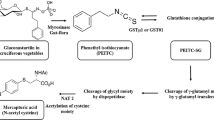Abstract
Purpose
Cyanidin-3-glucoside (C3G), an anthocyanin component of fruits and berries, possesses cancer chemopreventive properties in mouse models of carcinogenesis. Its pharmacokinetics and metabolism in mice have hitherto not been studied.
Methods
C57BL6J mice received C3G by either gavage at 500 mg/kg or tail vein injection at 1 mg/kg. Blood, urine, bile and heart, lung, kidney, liver, prostate, brain and gastrointestinal (gi) mucosal tissues were obtained up to 2 h after administration. Levels of C3G and its anthocyanin metabolites were determined by HPLC with visible detection. Metabolites were identified by LC/MS/MS.
Results
After oral administration peak concentrations of anthocyanins occurred within 30 min after administration. Levels were highest in the urine and gi mucosa. In the gi mucosa and liver the predominant flavonoid species after oral administration was C3G, whilst after iv dosing the majority of anthocyanins was C3G metabolites. After oral or iv administration, C3G half-lives in the different biofluids and tissues ranged from 0.7 to 1.8 h and 0.3 to 0.7 h, respectively. Systemic bioavailabilities for parent C3G and total anthocyanins were 1.7 and 3.3%, respectively. The major metabolites of C3G were products of methylation and glucuronidation. Cyanidin was a minor metabolite in the gut.
Conclusion
C3G and its metabolites were recovered from murine tissues which may be targets for cancer chemopreventive intervention. Anthocyanin levels achieved in the gi mucosa, prostate and the kidneys were of an order of magnitude consistent with pharmacological activity.




Similar content being viewed by others
References
Cooke D, Steward WP, Gescher AJ, Marczylo T (2005) Anthocyans from fruits and vegetables—does bright colour signal cancer chemopreventive activity? Eur J Cancer 41:1931–1940
Wang LS, Stoner GD (2008) Anthocyanins and their role in cancer prevention. Cancer Lett 269:281–290
Ding M, Feng RT, Wang SY, Bowman L, Lu YJ, Qian Y, Castranova V, Jiang BH, Shi XL (2006) Cyanidin-3-glucoside, a natural product derived from blackberry, exhibits chemopreventive and chemotherapeutic activity. J Biol Chem 281:17359–17368
Cooke DN, Schwarz M, Boocock DJ, Winterhalter P, Steward WP, Gescher AJ, Marczylo TH (2006) Effect of cyanidin-3-glucoside and an anthocyanin mixture from bilberry on adenoma development in the ApcMin mouse model of intestinal carcinogenesis—relationship with tissue anthocyanin levels. Int J Cancer 119:2213–2220
Ichiyanagi TY, Shida MM, Rahman Y, Hatano H, Matsumoto M, Hirayama KonishiT (2005) Metabolic pathway of cyanidin 3-O-beta-d-glucopyranoside in rats. J Agric Food Chem 53:145–150
Ichiyanagi TY, Shida MM, Rahman Y, Hatano H, Konishi T (2005) Extended glucuronidation is another major path of cyanidin 3-O-beta-d-glucopyranoside metabolism in rats. J Agric Food Chem 53:7312–7319
Schwarz M, Hillebrand S, Habben S, Degenhardt A, Winterhalter P (2003) Application of high-speed countercurrent chromatography to the large-scale isolation of anthocyanins. Biochem Eng J 14:179–189
Workman P, Twentyman P, Balkwill F, Balmain A, Chaplin D, Double J, Embleton J, Newell D, Raymond R, Stables J, Stephens T, Wallace J (1998) United Kingdom Co-ordinating Committee on Cancer Research (UKCCCR) guidelines for the welfare of animals in experimental neoplasia (second edition). Br J Cancer 77:1–10
McGhie TK, Walton MC (2007) The bioavailability and absorption of anthocyanins: towards a better understanding. Molec Nutr Food Res 51:702–713
Matsumoto H, Inaba H, Kishi M, Tominaga S, Hirayama M, Tsuda T (2001) Orally administered delphinidin 3-rutinoside and cyanidin 3-rutinoside are directly absorbed in rats and humans and appear in the blood as the intact forms. J Agric Food Chem 49:1546–1551
Ichiyanagi TY, Shida MM, Rahman Y, Hatano H, Konishi T (2006) Bioavailability and tissue distribution of anthocyanins in bilberry (Vaccinium myrtillus L.) extract in rats. J Agric Food Chem 54:6578–6587
Borges G, Roowi S, Rouanet JM, Duthie GG, Lean MEJ, Crozier A (2007) The bioavailability of raspberry anthocyanins and ellagitannins in rats. Molec Nutr Food Res 51:714–725
Manach C, Williamson G, Morand C, Scalbert A, Remesy C (2005) Bioavailability and bioefficacy of polyphenols in humans. I. Review of 97 bioavailability studies. Am J Clin Nutr 81:230S–242S
Galvano F, La Fauci L, Lazzarino G, Fogliano V, Ritieni A, Ciappellano S, Battistini NC, Tavazzi B, Galvano G (2004) Cyanidins: metabolism and biological properties. J Nutr Biochem 15:2–11
Felgines C, Talavera S, Texier O, Gil-Izquierdo A, Lamaison JL, Remesy C (2005) Blackberry anthocyanins are mainly recovered from urine as methylated and glucuronidated conjugates in humans. J Agric Food Chem 53:7721–7727
Meiers S, Kemeny M, Weyand U, Gastpar R, von Angerer E, Marko D (2001) The anthocyanidins cyanidin and delphinidin are potent inhibitors of the epidermal growth-factor receptor. J Agric Food Chem 49:958–962
Fleschhut J, Kratzer F, Rechkemmer G, Kulling SE (2006) Stability and biotransformation of various dietary anthocyanins in vitro. Eur J Nutr 45:1–7
Vitaglione P, Donnarumma G, Napolitano A, Galvano F, Gallo A, Scalfi L, Foglian V (2007) Protocatechuic acid is the major human metabolite of cyanidin-glucosides. J Nutr 37:2043–2048
Ichiyanagi T, Rahman MM, Hatano Y, Konishi T, Ikeshiro Y (2007) Protocatechuic acid is not the major metabolite in rat blood plasma after oral administration of cyanidin 3-O-beta-d-glucopyranoside. Food Chem 105:1032–1039
Kern M, Fridrich D, Reichert J, Skrbek S, Nussher A, Hofem S, Vatter S, Pahlke G, Rufer C, Marko D (2007) Limited stability in cell culture medium and hydrogen peroxide formation affect the growth inhibitory properties of delphinidin and its degradation product gallic acid. Molec Nutr Food Res 51:1163–1172
Acknowledgments
The study was funded by programme grant C325/A6691 from Cancer Research UK. We thank Prof. P. Winterhalter and Dr. M. Schwarz (Department of Food Chemistry, University of Braunschweig) for the isolation of C3G.
Author information
Authors and Affiliations
Corresponding author
Rights and permissions
About this article
Cite this article
Marczylo, T.H., Cooke, D., Brown, K. et al. Pharmacokinetics and metabolism of the putative cancer chemopreventive agent cyanidin-3-glucoside in mice. Cancer Chemother Pharmacol 64, 1261–1268 (2009). https://doi.org/10.1007/s00280-009-0996-7
Received:
Accepted:
Published:
Issue Date:
DOI: https://doi.org/10.1007/s00280-009-0996-7




